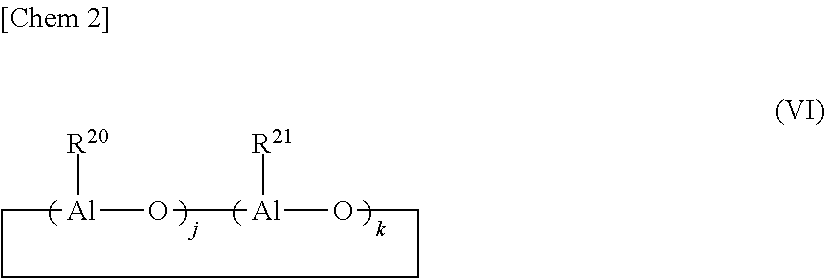Method for producing a-olefin oligomer, a-olefin oligomer, and lubricating oil composition
- Summary
- Abstract
- Description
- Claims
- Application Information
AI Technical Summary
Benefits of technology
Problems solved by technology
Method used
Image
Examples
example 1
[0107]First, 250 mL of 1-decene were loaded into a glass container dried by heating and having an internal volume of 300 mL under a nitrogen atmosphere. Then, 1.2 mL of a 1 mol / L methylaluminoxane (MAO) were added to the container, and the temperature of the mixture was increased to 50° C. Next, 4 mL of a solution of bis(t-butylcyclopentadienyl)zirconium dichloride in toluene with its concentration adjusted to 10 mmol / L were added to the mixture, and the whole was subjected to a reaction at a hydrogen pressure of 5 kPa (G) and 50° C. for 6 hours. In the experiment, an Al amount was 9.07×10−4 mol per mol of 1-decene, and a ratio (molar ratio) “aluminum / transition metal compound” was 30.
[0108]The reaction was stopped with 50 mL of 1 mass % dilute hydrochloric acid, and the reaction product was washed with 50 mL of deionized water twice so that a catalyst component might be decomposed and removed. The analysis of the resultant solution by gas chromatography showed that the selectivity ...
example 2
[0109]A solution was prepared in the same manner as in Example 1 except that bis(trimethylsilylcyclopentadienyl)zirconium dichloride was used as a transition metal compound. The selectivity of a dimer or more was as follows: the selectivities of a dimer, a trimer, a tetramer, a pentamer, and a hexamer or more were 25 mass %, 24 mass %, 10 mass %, 6 mass %, and 35 mass %, respectively. In addition, the elemental analysis of the solution showed that the solution contained Cl, Al, and Zr at contents of less than 2 ppm by mass each, and was hence substantially free of any catalyst residue. In addition, it can be found that an oligomer selectivity is high because of the following reason: the ratios A, B, and C are 0.96, 0.42, and 0.60, respectively, so the relationships of A>B and A>C are satisfied.
example 36
[0112]A solution was prepared in the same manner as in Example 1 except that bis(ethylcyclopentadienyl)zirconium dichloride was used as a transition metal compound. The selectivity of a dimer or more was as follows: the selectivities of a dimer, a trimer, a tetramer, a pentamer, and a hexamer or more were 28 mass %, 10 mass %, 7 mass %, 5 mass %, and 50 mass %, respectively. In addition, the elemental analysis of the solution showed that the solution contained Cl, Al, and Zr at contents of less than 2 ppm by mass each, and was hence substantially free of any catalyst residue. In addition, it can be found that the selectivity of each of the trimer, the tetramer, and the pentamer is low because of the following reason: the ratios A, B, and C are 0.36, 0.70, and 0.71, respectively, so the relationships of A>B and A>C are not satisfied.
PUM
| Property | Measurement | Unit |
|---|---|---|
| Temperature | aaaaa | aaaaa |
| Fraction | aaaaa | aaaaa |
| Pressure | aaaaa | aaaaa |
Abstract
Description
Claims
Application Information
 Login to View More
Login to View More - Generate Ideas
- Intellectual Property
- Life Sciences
- Materials
- Tech Scout
- Unparalleled Data Quality
- Higher Quality Content
- 60% Fewer Hallucinations
Browse by: Latest US Patents, China's latest patents, Technical Efficacy Thesaurus, Application Domain, Technology Topic, Popular Technical Reports.
© 2025 PatSnap. All rights reserved.Legal|Privacy policy|Modern Slavery Act Transparency Statement|Sitemap|About US| Contact US: help@patsnap.com



